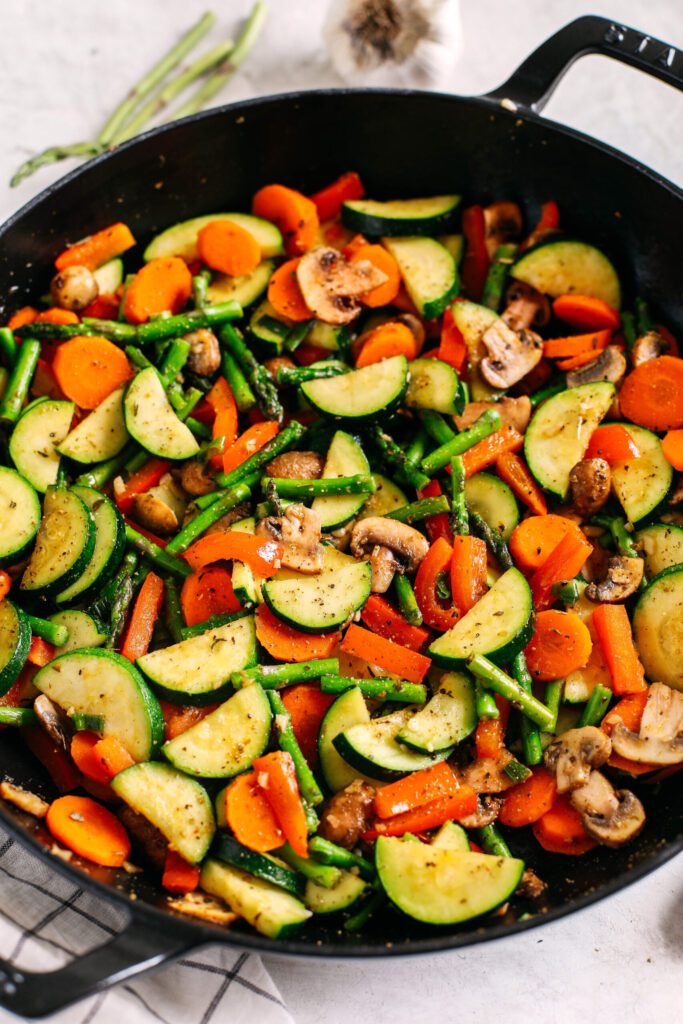Sautéing is a cooking technique that can elevate your cooking game to the next level. It involves cooking ingredients quickly in a skillet with high heat and a small amount of oil or fat. Sautéing is versatile and can be applied to various foods. It is a great way to cook healthy meals as it requires less oil than other cooking methods and preserves natural flavors and colors. Tips for sautéing include using the right pan, preheating the pan, using the right amount of oil or fat, cutting ingredients into uniform pieces, not crowding the pan, and seasoning the ingredients. Sautéing recipes for vegetables and meat are provided.
Sautéing: The Secret to Perfectly Cooked Vegetables and Meat
If you want to elevate your cooking game to the next level, you should learn sautéing – a cooking technique that emphasizes the use of high heat and a small amount of oil or fat. Sautéing involves cooking your ingredients quickly in a skillet, tossing or stirring them constantly. The result is a flavorful and tender dish that’s also healthy and wholesome.
Why Sautéing Is Important
Sautéing is an essential technique in many cuisines – from French to Chinese to Italian. It’s a versatile, fast, and simple way of cooking that can be applied to vegetables, meats, and seafood. Sautéing is great for cooking healthy meals because it requires less oil than other cooking methods, like deep-frying or simmering, and preserves the natural flavors and colors of the ingredients.
Getting Started with Sautéing
If you’re new to sautéing, here are some tips and tricks to help you get started:
1. Choose the Right Pan
The ideal pan for sautéing is a deep, heavy-bottomed skillet or sauté pan. It should have sloping sides that allow you to easily toss or stir the ingredients. The size of the pan will depend on the quantity of food you’re cooking. If you overcrowd the pan, the food will steam instead of sauté, and you won’t get that crispy texture that’s characteristic of sautéing.
2. Preheat Your Pan
Before you start sautéing, preheat your pan over medium-high heat for a few minutes. You can test if the pan is hot enough by sprinkling a few drops of water over it – if they sizzle and evaporate instantly, the pan is ready.
3. Use the Right Amount of Oil or Fat
You don’t need a lot of oil or fat when sautéing – just enough to coat the ingredients and prevent them from sticking to the pan. For vegetables, you can use vegetable or olive oil, and for meats or seafood, you can use butter or clarified butter (also known as ghee). Heat the oil or fat in the pan until it’s shimmering before adding the ingredients.
4. Cut Your Ingredients into Uniform Pieces
To ensure that your ingredients cook evenly, cut them into uniform pieces. For vegetables, you can chop them into bite-sized pieces, or slice them thinly depending on the recipe. For meats, you can cut them into strips, cubes, or medallions, depending on the cut and the dish you’re making.
5. Don’t Crowd the Pan
As mentioned earlier, overcrowding the pan will prevent your ingredients from sautéing properly. You should leave enough space between the pieces of food, so they have room to cook and get that crispy texture. For large quantities of food, you can sauté them in batches, then combine them at the end.
6. Season Your Ingredients
Sautéing is an excellent way to bring out the natural flavors of your ingredients, but you should also add some seasoning to enhance the taste. You can use simple seasonings like salt, black pepper, and herbs, or experiment with different spices and marinades for more complex flavor profiles.
Sautéing Vegetables
When it comes to sautéing vegetables, the possibilities are endless. You can sauté leafy greens like spinach or kale, root vegetables like carrots or potatoes, or cruciferous vegetables like broccoli or cauliflower. Here’s a simple recipe for sautéed green beans:
Ingredients:
- 1 pound green beans, trimmed
- 2 cloves garlic, minced
- 2 tablespoons olive oil
- Salt and black pepper, to taste
Instructions:
- Heat the olive oil in a skillet over medium-high heat.
- Add the green beans and garlic to the pan and sauté for 5-7 minutes, stirring frequently.
- Season with salt and black pepper to taste.
- Serve hot as a side dish.
Sautéing Meat and Seafood
Sautéing is also a great way to cook meat and seafood, especially if you’re in a hurry. You can sauté chicken, beef, pork, fish, or shrimp, depending on the recipe. Here’s a recipe for sautéed shrimp with garlic and lemon:
Ingredients:
- 1 pound raw shrimp, peeled and deveined
- 4 cloves garlic, minced
- 2 tablespoons clarified butter
- 1 lemon, juiced and zested
- Salt and black pepper, to taste
Instructions:
- Heat the clarified butter in a skillet over medium-high heat.
- Add the garlic and sauté for 1-2 minutes, until fragrant.
- Add the shrimp to the pan and sauté for 3-4 minutes, stirring frequently.
- Season with salt, black pepper, lemon juice, and zest.
- Serve hot as a main course or appetizer.
Conclusion
Sautéing is a simple yet effective technique that can transform your cooking. By using high heat and a small amount of oil or fat, you can create flavorful and healthy dishes that are perfect for any occasion. Whether you’re sautéing vegetables or meats, don’t be afraid to experiment with different ingredients and seasonings to find your own unique style.
